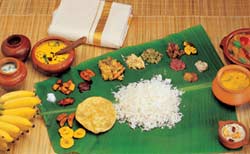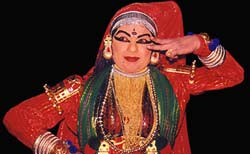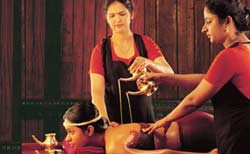The crusty model of penance and austerity, Parasurama, would never have imagined that his trusty, weather-beaten old axe would transform into the hauntingly beautiful Kerala — an undulating verdant stretch of land bordered by the delicate lace of the waves of the Arabian Sea on the west and the towering creases of the Western Ghats on the east. A visit to the land of kera vrikshas (coconut trees) delivers an invigorating punch to the sensory organs, with its natural beauty providing stimulation as much as the culture and cuisine.
 |
| A coverlet of green |
As you motor through the interiors of the state, the green of the coconut, areca, cashew, mango, teak, rubber, tamarind, banana and jackfruit trees coalesce into a soothing tapestry bordering the road. The foliage thins out sometimes to reveal tiny, one and two street towns, with the green never far behind, and geometrically laid out handkerchiefs of young, green or nearing-harvest, gold paddy fields. The silver of a meandering stream sometimes frills the distant edges of the billowing surface of the green and gold carpet or appears as a broad sheet under a bridge. The air is faintly redolent with the smell of spices. Through the green curtain, you espy
traditional houses with their characteristic, sloping, tiled roofs.
Heady pageants
 |
| Elephants dressed to kill |
Although, any time is a fine time to visit Kerala, since most of the temples in Kerala hold their grand annual festivals between January and April, a visit during this period can turn out to be an unforgettable experience. Filled with the thunder of the panchavadyam and thayambaka (musical ensembles performed with five and two musical instruments, respectively), the colour of gold-caparisoned elephants (ranging from 2 to over 50), the spectacle of the kodamattam (display of umbrellas of brilliant colours by the mahouts sitting on the elephants), and the appreciative roar of pulsing crowds, the temple festivals are worth a see. The most eagerly awaited is the Trissur pooram (festival), which is a perfect combination of all the above ingredients. Mad, enthusiastic connoisseurs who travel from one festival to another, sometimes within a span of days, rooting for their favourite elephants or panchavadyam and thayambaka artisans is nothing new.
 |
| An unusual plate to serve a scrumptious feast |
You can also visit during the Tourism Week celebrations of the Kerala Government, which coincides with Onam (August-September), a major festival of Keralites. During Onam, travelling through the rural areas, you come across beautiful patterns made with colourful flowers on mud floors slicked over with cow dung at the entrance of residences. These artistic creations adorn the courtyards for nearly a month. You also get to taste various traditional Onam delicacies served on a plantain leaf, a green initiative unique to the state of Kerala. The government organises the annual chundan vallam (beaked boat) race during the tourism week at Punnamada lake in Alappuzha district for the Nehru Trophy. Eager travellers from far and near congregate to witness this joyous celebration of healthy competition and team spirit.
 |
| Getting that Kathakali gesture just right |
You can see a rich array of the performing arts of Kerala such as kathakali, ottanthullal, chakyarkoothu, chavittunatakam, etc at various temple festivals and during the tourism week celebrations. However, if you want to see them all under one roof, you could visit the Kerala Kalamandalam at Cheruthuruthi — a deemed university for art and culture — and maybe take up a residential course to learn one of them.
Fine-tuning your body
 |
| Unraveling those tight knots with Ayurveda |
Kerala is synonymous with Ayurveda (the science of life), a system of medicine indigenous to India. During your holiday, you could slip in a visit to the Aryavaidyashala at Kottakal, a 100-plus-year-old institution known the world over as a seat of Ayurveda, for some pancha karma (five actions), a cleansing and rejuvenating program for the body and mind, and emerge a new, younger more beautiful you.
If you have time at hand, sign up for a
 |
| Kalaripayatu acrobatics |
beginners' course of kalari (gymnasium) payattu (exercise), an autochthonal martial art form of Kerala, at a kalari to tone your body and control your mind; but, remember, perfection is the reward of years of hard work. Damaged marmas (vital pressure points in the body) are also treated in the kalaris through kalari marma chikitsa (treatment), a unique system of physiotherapy. In times past, each village had a kalari, but now they are few and far between. Kalariyil Dharmikam Ashram at Parassala is one such kalari providing training and treatment.
Additional lures
The cuisine could leave your mouth on fire with Kuttanad (the rice bowl of Kerala, below sea level) culinary preparations; you could soothe it down with payasam, a concoction of milk or coconut milk; rice, jackfruit or ripe bananas; jaggery or sugar; and dry fruits, in varying combinations. The cuisine varies depending on the region, but coconut and rice form the staple of many dishes — both are produced abundantly in the region. Tapioca is another crop grown extensively and used as a substitute for rice by the poor — though now it is served as a delicacy in many eateries.
The beaches of Kovalam; the tea and spice gardens of Wyanad and Munnar; the Periyar Wildlife Sanctuary at Thekkady; the ancient monuments of Thiruvananthapuram; the old churches, temples and mosques dotting the state; and the backwater boat rides of Alappuzha — routine tourist destinations — are other attractions which you could partake of when visiting the slice of paradise called Kerala.
Images courtesy: Department of Tourism, Government of Kerala




























